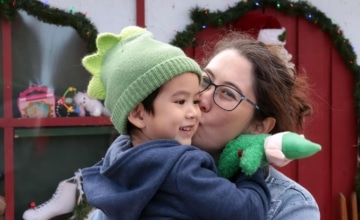Learn how to prepare for R&R leave so that you, your Service Member, and your baby or toddler can make the most of these 14 precious days.
Deployments are hard. There’s no way around it. You miss your Service member, and worry about him. Rest and Recuperation (R&R) leave is often a wonderful opportunity for the whole family to reconnect with your Service member. But many families—as excited as they may be for this visit—also find that they are experiencing many emotional highs and lows.
Preparing for R&R Leave: Your Feelings
You and your child have already had at least a few months into your Service member’s deployment to adjust, find a new rhythm, and, barring the occasional mishap or emotional “hiccup,” work your way into a comfortable routine. It may not be the ideal situation, but you and your family are coping as well as you can. Now, in the midst of all this adjusting and settling in, your Service member is scheduled to come home on R&R leave? How fun. How exciting. How exhilarating. How confusing!
This range of feelings is very normal. You’re looking forward to seeing your Service member, but you don’t want to disrupt the new routine you’ve created for you and your child. You can’t wait for Service Member to get here, but you are already feeling sad, or even mad, about saying good-bye again. This emotional roller coaster can leave you feeling stressed, sad, excited, happy, and impatient as you anticipate another reunion and departure. As you prepare for your Service member’s leave, there are two important things to keep in mind:
- There is no “right” way to feel. What matters most is how your emotions affect you and your family. Being aware of how you are feeling helps you make a plan for coping. What are you most excited about? What are you most worried or sad about? Think through what support you need to manage another set of changes. A first step can be to check out the wide range of resources at Military Onesource: [ www.militaryonesource.com](www.militaryonesource.com) or 1-800-342-9647. Remember that your child senses your feelings and responds in her own way. Taking care of yourself is an important way that you can help your young child feel safe and secure.
- Be aware of your expectations. You may have a long list of things you’d like to see and do during your spouse’s visit. Resolving longstanding disagreements, renegotiating household roles, and re-establishing close parent-child bonds are just some of the issues that families try to tackle during a leave period. Although important, each of these tasks requires time and patience. Try to be flexible in your goals for this limited time period. Remember that once this current deployment ends you will have a longer period of time to work through these issues. For now, try to focus on enjoying this special time together.
Preparing Your Child for Two-Week Leave
Because of your hard work and loving care, your child has probably settled into a comfortable pattern, or routine, after his parent’s deployment. Now, his little world is being rocked—again—by another reunification and separation. You can continue to support your young child by remaining sensitive to his individual needs. Here are some tips and strategies for helping your child before, during, and after the visit.
*** Help prepare your child for the visit, even if he doesn’t understand everything that is happening.** Young children thrive on routine and predictability. Knowing what to expect helps them to feel emotionally grounded. As you prepare for your Service member’s return, let your child know what is happening: “I’m sorry I’m not able to play as much with you today. I’m trying to make the house look extra nice for Mommy’s visit tomorrow. She will be home with us for two weeks. Then she will go back to Iraq because her work trip is not over yet. I’m really excited about seeing her. Mommy will be so happy and excited to see you! Two weeks is 14 days…let’s go stack 14 blocks to see how many days that is…”
- Create a visual of the R&R leave. Use paper chains, paper clips, blocks, or even socks hanging on a line. Have your child (with her Service member) remove a block each day of the leave so that she can anticipate the coming separation.
- **Expect the unexpected. **There are many factors that may influence your child’s response to his returning parent, including his temperament and stage of development. These factors can make it difficult, if not impossible, to predict his reaction to the return of your Service member. He might run into his parent’s arms, or he might run in the opposite direction and cry. He might want to show his Service member parent all of his toys, or he might want to ignore him. He might want to be held by his Service member parent, or he might want to hold on to your leg. As the family settles into leave, your child’s response might change. These reactions can be hard on you and your Service member. Of course, it’s difficult not to take the behaviors personally. Try to remember that your child’s response is a reflection of his confusion over this latest transition. The more flexible you and your Service member are, the more safe and secure your child will feel throughout the visit.
- Let your child go at her own pace. Your child will know when she feels comfortable reaching out to her Service member parent. It might be immediately, or it might take some time. Try not to force your child into spending “alone time” with the Service member if she is not yet ready. This may seem hard, particularly when leave time is limited. Perhaps, at first, you might spend time together as a family. As your child begins to feel more comfortable, she and her Service member parent can spend some one-on-one time together. When your Service member responds to your child’s cues, giving her the time and space she needs to adjust, their relationship grows stronger.
- Try to balance fun with predictability. There’s so much you want to do during this short amount of time. It’s easy to make every day of the visit filled with celebrations and grand adventures. Remember that it’s just as important to get reacquainted through the everyday moments that are already part of your daily routines. Bath-time play, bedtime reading, blowing bubbles, taking walks, or playing peek-a-boo are just some of the many activities that your child and his Service member parent can share. You might even consider recording or videotaping these everyday interactions between your child and his Service member parent. These moments can help your child remember his parent—a gift for both Service Member and child for the remainder of the deployment.
Saying Good-bye Again
Unfortunately, R&R leave must end. Here are some tips for making this latest transition a “good good-bye”:
- Anticipate some post-leave challenges. Just when you’ve started to reconnect, it’s time for your Service member to leave again. This transition is hard on everyone, including your child. Once again, she is trying to make sense of why her parent is leaving. Your child is counting on your support during the transition. Continue to talk with your child about her Service member parent, building on the new memories you made during the visit. Share the recordings you made, or photos you took, of her and her Service member parent. Encourage your older toddler to draw pictures of her and her Service member parent having fun together. Understand that, once again, your child may express her feelings through her behaviors. For example, she might seem more “clingy” when saying good-bye and need some extra reassurance that you will come back. Summon all of your patience and understanding, knowing that, in spite of the challenges, your two weeks together as a family was well worth the effort.
- Remember that your child’s behavior has meaning. Your little one misses his Service member parent as well. A young child can experience many different emotions when a parent deploys. He misses his parent and may feel sad, confused, angry, or distressed as he tries to cope with this transition. Babies and toddlers don’t necessarily have the words to describe how they’re feeling, but they can “talk” to us through their behaviors. You may see: tantrums, fussiness, a return to earlier behaviors (such as thumb sucking), withdrawal from people or activities, or changes in eating or sleeping schedules. These are just some of the ways that very young children tell us how they’re feeling. Remember, if you ever feel confused or concerned about your child’s behavior, contact your child’s health care provider, pediatrician, or an early childhood specialist for additional information and support.
- Access support when you need it. Getting help from others can be an important part of coping as well as a sign of resilience. If you feel like you are having a hard time dealing with your own feelings, consider talking to a professional counselor, your physician, clergy, or friends for support and guidance. Reaching out and keeping yourself emotionally strong is an essential part of parenting. When your own needs are met, you will have more energy to respond to your child’s needs.
- Remember that your child knows how you are feeling. Another important reason to take care of yourself after this latest transition is that babies and toddlers are very sensitive to the feelings of their caregivers. When you are sad, they feel sad, worried, and anxious too. As you settle into the deployment again and are able to manage your own emotions, you’ll be able to help your child to manage hers as well. When you respond in a caring, consistent way to your child’s feelings and behaviors, she feels nurtured and understood. Remember, you don’t have to be perfect…you just have to show your child that you’re doing your best to help her feel safe and secure.




